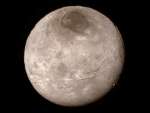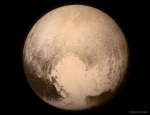
|
Astronomy Picture Of the Day (APOD)
 Comet PanSTARRS, Moon, and Venus
Comet PanSTARRS, Moon, and Venus
22.07.2015
It is the object to the left of the big tree that's generating much recent excitement. If you look closely, there you can see Comet PanSTARRS, complete with two tails. During July, this comet has increased markedly in brightness and has just passed its closest approach to Earth.
 Gamma ray Rain from 3C 279
Gamma ray Rain from 3C 279
21.07.2015
If gamma-rays were raindrops a flare from a supermassive black hole might look like this. Not so gently falling on the Fermi Gamma-ray Space Telescope from June 14 to June 16 the gamma-ray photons, with energies up to 50 billion electron volts, originated in active galaxy 3C 279 some 5 billion light-years away.
 Comet Tails and Star Trails
Comet Tails and Star Trails
20.07.2015
After grazing the western horizon on northern summer evenings Comet PanSTARRS (also known as C/2014 Q1) climbed higher in southern winter skies. A visitor to the inner Solar System discovered in August 2014 by the prolific panSTARRS survey, the comet was captured here on July 17.
 Comet PanSTARRS and a Crescent Moon
Comet PanSTARRS and a Crescent Moon
19.07.2015
A comet has brightened quickly and unexpectedly. Discovered last year, Comet C/2014 Q1 (PanSTARRS) is expected to be visible now for a few days to the unaided eye, just after sunset, from some locations. The comet rounded the Sun on July 6 and apparently has shed quite a bit of gas and dust.
 The First Rocket Launch from Cape Canaveral
The First Rocket Launch from Cape Canaveral
18.07.2015
A new chapter in space flight began this week in 1950 July with the launch of the first rocket from Cape Canaveral, Florida: the Bumper V-2. Shown above, the Bumper V-2 was an ambitious two-stage rocket program that topped a V-2 missile base with a WAC Corporal rocket.
 Fly Over Pluto
Fly Over Pluto
17.07.2015
It took 9.5 years to get this close, but you can now take a virtual flight over Pluto in this animation of image data from the New Horizons spacecraft. The Plutonian terrain unfolding 48,000 miles (77,000 kilometers) below is identified as Norgay Montes, followed by Sputnik Planum.
 Charon
Charon
16.07.2015
Icy world Charon is 1,200 kilometers across. That makes Pluto's largest moon only about 1/10th the size of planet Earth but a whopping 1/2 the diameter of Pluto itself. Charon is seen in unprecedented detail in this image from New Horizons.
 50 Miles on Pluto
50 Miles on Pluto
15.07.2015
A 50 mile (80 kilometer) trip across Pluto would cover the distance indicated by the scale bar in this startling image. The close-up of the icy world's rugged equatorial terrain was captured when the New Horizons spacecraft was about 47,800 miles (77,000 kilometers) from the surface, 1.5 hours before its closest approach.
 Pluto Resolved
Pluto Resolved
14.07.2015
New Horizons has survived its close encounter with Pluto and has resumed sending back images and data. The robotic spacecraft reported back on time, with all systems working, and with the expected volume of data stored.
 New Horizons Passes Pluto and Charon
New Horizons Passes Pluto and Charon
13.07.2015
Will the New Horizons spacecraft survive its closest approach to Pluto and return useful images and data? Humanity will know in a few hours. Regardless of how well it functions, New Horizon's rapid...
|
January February March April May June July August September October November December |
||||||||||||||||||||||||||||||||||||||||||||||||||||||||